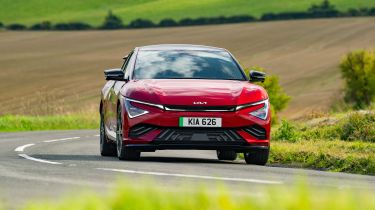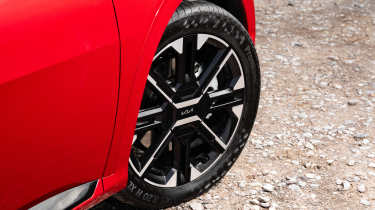Kia EV6: performance, motor & drive
While some EVs are compromised by their weight, the EV6 mostly manages to shrug this off and deliver an enjoyable driving experience
| Model | 0-62mph | Top speed | Driven wheels | Power |
| RWD | 7.7s | 115mph | Rear | 225bhp |
| AWD | 5.3s | 116mph | Four | 320bhp |
The Kia EV6’s facelift hasn’t seen any notable changes in terms of power, but then again no version of the Kia EV6 could be called slow to begin with. Not only does the Kia look like one of the sportier members of the Electric Global Modular Platform (E-GMP) family, but it drives like it, too.
Kia EV6 0-62mph, top speed and acceleration
Even the entry-level RWD version covers the 0-62mph dash in 7.7 seconds, courtesy of its 225bhp electric motor. And this power is delivered in the typical smooth and silent fashion that you’d expect from an electric powertrain. The base configuration has no trouble getting up to motorway speeds and can even perform motorway overtakes without breaking sweat. It can feel a little sluggish in ‘Normal’ and ‘Eco’ mode, though, because both limit power to preserve range.
If you like being thrown back in your seat or are simply after some extra grip in the colder and wetter months, there’s always the AWD model. The addition of a second electric motor on the front axle not only provides four-wheel-drive traction, but also boosts power to 320bhp.
Ultimately, given that the AWD model is able to reach 62mph in just 5.3 seconds, the EV6 GT feels a tad superfluous; we doubt most family buyers will really need that level of performance. However, if you really can’t resist 577bhp and a neck-snapping 3.5-second 0-62mph time, we've reviewed it separately if you want to find out more.
Handling
The Kia EV6 isn’t what you would call lightweight, even by EV standards – dual-motor models weigh in at over two-and-a-half tonnes. Yet, while the boffins at Kia haven’t quite managed to disguise the EV6’s mass in its entirety, they’ve certainly tried their best, and succeeded for the most part.
As we've mentioned, progress is swift in the EV6, but it's also quiet; even at motorway speeds, wind, tyre and electric-motor noise are kept to a reasonable level, which isn't always the case with electric cars. Kias of late have all had rather stiff suspension and the EV6 is no different; this doesn’t make the car uncomfortable to travel in and actually benefits its handling. The EV6’s steering is consistent and nicely weighted, making it quite a bit more enjoyable to drive than the comparatively cushy Hyundai Ioniq 5.
Having sampled both the rear and four-wheel-drive versions of the EV6 on UK roads, we can confidently state that the latter isn't really worth the premium you'll pay over the entry-level version. While it is usefully quicker than the rear-drive version in a straight line, the four-wheel-drive EV6's additional power only compounds the issue of the chassis feeling somewhat overwhelmed by the power on offer. Throw in the fact that the rear-drive version returns more range from a charge, and the choice becomes pretty clear-cut.
The EV6 GT is a different animal, however. Kia has tuned the EV6’s range flagship to be really stiff at the back and a little softer at the front, which improves turn-in response and limits rear-end squat when you pile on the throttle. Down a twisty back road the GT is fantastic, although there’s more motorway noise than we’d like. The steering rack needs fewer turns than the standard EV6 to go from lock-to-lock, but that means that three-point turns and tight manoeuvres can be tricky. On the right road, though, you won’t mind at all.


